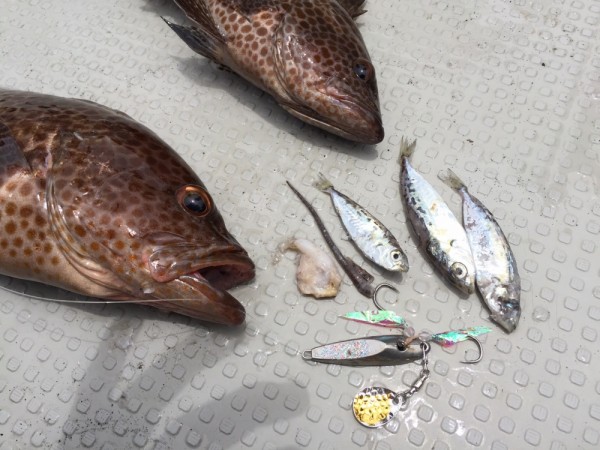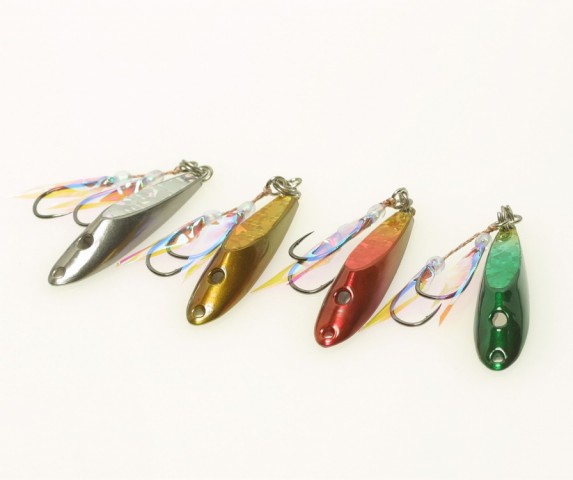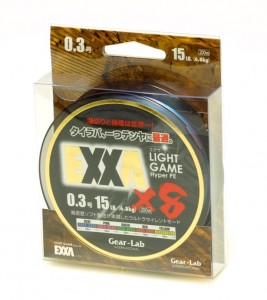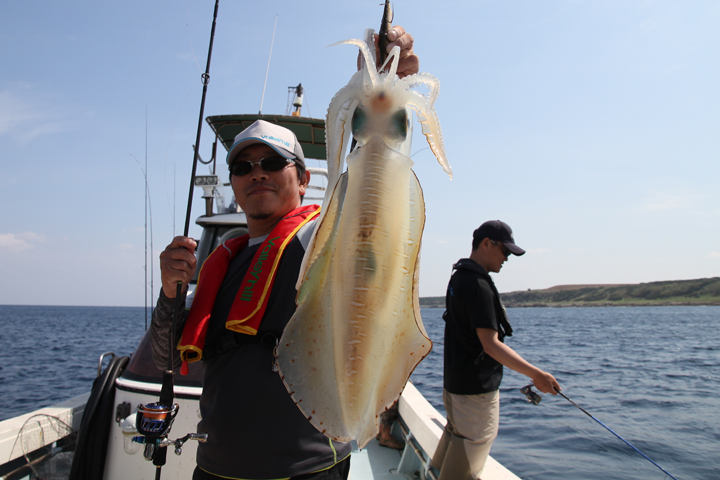Micro Jigging with Slow Pitch Jig?
There still seems to be a confusion about micro jigging and slow pitch jigging. I get inquiries like “I do micro jigging. Which slow pitch jigs are good to use?” It seems to me that some people just think “slow pitch jigs are good.” and “I want to use them in my game.”
Well, sometimes you gotta know how to use each jig so that the piece of metal turns into a lively movement.
Micro Jigging
Let’s talk about micro jigging first.
They define micro baits as 5 – 6cm (about 2 inch) long or smaller baits. They say that micro baits are the main prey for predatory fish. i.e. It is what they usually eat.
Well, if you think of the population of different sizes, it seems to be a natural consequence.
So, the idea of micro jigging is simply to mimic what fish eats the most. By using a micro jig. So the size of the jig is the most important factor.
We can’t talk about micro jig without Tungsten metal. Tungsten is a rare metal. It’s not available much. It’s difficult to process because it’s so hard that you need a diamond cutter. Therefore, it’s expensive. But Tungsten is heavy. Its specific gravity is 1.7 times greater than lead which other jigs are made of. So for the same weight, tungsten jig can be 60% smaller than lead jig.
Micro Flip by Gear-Lab
There are several Tungsten jigs in the market. Probably the most popular jig is Micro Flip by Gear-Lab. This jig pumped up the heat for micro jigging in Japan anyway.
- 35g (48cm) for shallow water (50m-), JPY1980 – JPY2158
- 60g (51cm) for 50m+ of water or when the current is strong, JPY2763 – JPY2997
You can order with me but it’s very hard to get them right now. Please expect to wait a while.
Cast and Retrieve
Just like that. It’s simple. It requires no special rod. Any light rod. Spinning reel of #2500 or #3000 class. The line is recommended to be less than PE1.0.
Gear-Lab recommends this EXXA line PE0.3. It’s ridiculously strong 15lb class.
I don’t have much experience with this game. I’ve just done it a couple of times at 30m to 50m of water from a free drifting boat. All the groupers in the reefs loved it. I definitely found PE0.8 far better than PE1.5. With PE1.5, it was harder to feel the touch down and it felt like it blew the jig up off the bottom faster. PE1.5 catches more current which blows out more line slack, which, as a consequence, lifts the jig upward. I felt the jig swimming more with the PE0.8.
I used my light Eging rod. It’s got soft tip. And I found it very good to have soft tip. It helps it swallowed well and doesn’t flip off bites.
Size matters.
So that’s the basic concept. The idea is about using low-profile micro jig.
Can a slow pitch jig do micro jigging?
Now this is a point I’m trying to make.
I don’t think there’s a slow pitch jig that is smaller than 6cm size. I think that just answers it.
The key factor of micro jigging is Tungsten metal, I think. Because of its specific gravity, the jig can be low profile for the weight. And because of that size and weight, it catches much less water resistance than lead. It’s fast to fall. It’s easy to move against hydrodynamic resistance. Using light line will help it even more. That is why you can cast and still able to move the jig lively in the diagonal alignment.
On the contrary, slow pitch jig is slow to fall. Due to its lead metal, its shape, and its center-balance. And that is exactly why it’s attractive. And that is why it has to be used in vertical alignment.
What if you make a slow pitch jig with Tungsten metal? I don’t know. It can be interesting. It can open a new window for anglers.
But with a slow pitch jig as we know it, we need to use certain weight. Usually 1.5 or 2 times heavier than conventional jigs. Even at 30m to 40m, I use 100g. There are 60g and 80g slow pitch jigs on production. But if you are on free-drifting boat, forget about them. In most occasions, you want to use 100g or 130g at least.
Because;
- Heavy weight helps you stay as vertical as you can.
- Heavy weight helps the jig fall against the current pushing the line, which tries to pull the jig upward.
- Heavy weight makes the rod bend deep and spring back, getting a nice slow pitch action going, while light weight would just bend the tip and that would lead to up-up-up fast pulling action. (It may work OK, but then it doesn’t have to be an expensive slow pitch jig.)
But if the jig is too heavy, it falls unlively fast. And it doesn’t get hang-time or swim-time when the rod springs back.
So, we need to find tuning here. How heavy should the jig be? It depends on the water. That is the most important sense that slow pitch jiggers need to refine. How heavy is the water? Is your jig moving?
So, we are in the same physics of water, but micro jigging and slow pitch jigging have the total different approach to the fish.
Hope the information helps you! Good luck!
Related Posts
15 Comments
Leave a Reply Cancel reply
Categories
- 1. SPJ (57)
- 1-1. Principles (9)
- 1-2. Techniques (11)
- 1-3. Setup (17)
- 1-4. FAQ (19)
- 1-5. Tackles (3)
- 1-6. Video Gallery (2)
- 2. Other Offshore Games (5)
- 3. Fishing Report (105)
- 3-1. Totos (25)
- 3-2. Readers (72)
- 4. Fish Cooking (19)
- 4-1. Iki-Jime (3)
- 4-2. The Art of Sashimi (5)
- 4-3. Recipe (7)
- 4-4. Seasoning (3)
- 5. Fishing Charter (6)
- Fish (12)









I do micro jigging with slow pitch style using 40 gram metal jig ( non Tungsten ) in 20-40 meter water. Targeting snapper, grouper, Travelly. I think its very effective
what about the water current? , here in UAE fishing by ur way and it works fine , but I think in low current only
Micro jigging does not have to be so vertical as slow pitch jigging. When you have currents or winds that separates you from the jig, you just need to make fast lifts more. If you make suspensions and falls, you will be more separated and the jig will be just hanging in the water.
100g tg cultiva edge. You’ll never go back to standard lead. Get the silver zebra.
Cultiva TG Edge is getting very popular here too.
Dear Totos , can I use my surfcasting rod (Ugly stick GX2 ) which is lure weight 28 gram in light jigging ? if no ,why ?
Hi Ahmed.
Light jigging really doesn’t mean anything other than it’s a jigging game from a boat and it targets light game or it uses light jigs. it means no specific method. I would just say if it’s 6′ or longer spinning rod, it can be hard to handle on the boat.
Could you please tell me what is the ,best technique I have to use in less that 15 m depth ?
some times the water current is high , I uses 100g and 130g but no contacts , I want to try light jigging what is your advice ?
Hi Ahmed.
I would cast a little and do jigging in a diagonal alignment. I would try tungsten jigs too which enables you direct control.
Up, need reply for Last comment please
Sorry for my late reply, but there it is.
So are slow pitch jigs made from just lead? I was wanting to make my own
Hi Jamie.
Yes, it’s made of lead.
Enjoy!
Is slow pitch jigging also called slow jigging of there is a difference ?
Sato Sensei originally named it Slow Pitch Jigging. Then, people start calling it Slow Jigging because they don’t know what Pitch stands for.
But Sato Sensei insists that it is not about being slow. Reeling can be fast. Rod lifting can be fast. Pitch means one circle of actions, which are reeling, rod lifting, holding up and falling. In conventional fast jigging, you do the reeling and lifting so fast and so continuously, without holding up and falling. So, Pitch is like a frequency of actions and in this style of jigging, the pitch is slow.